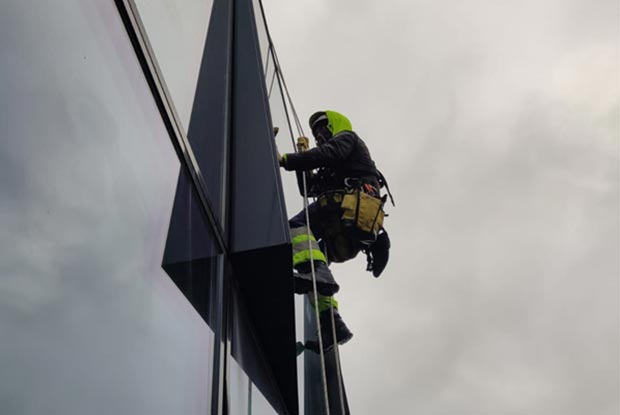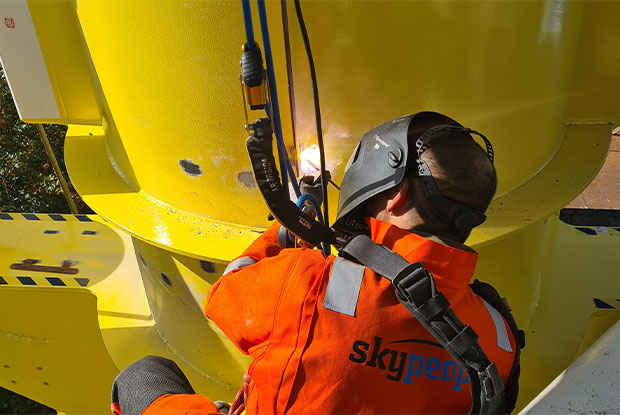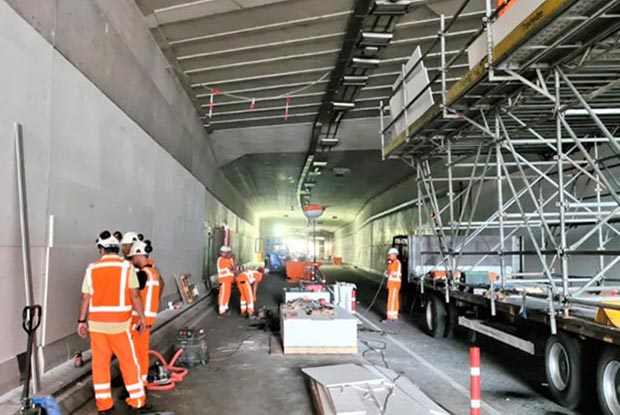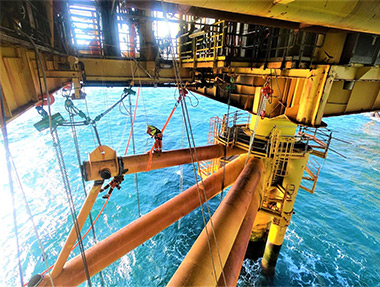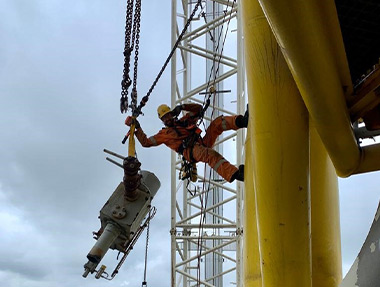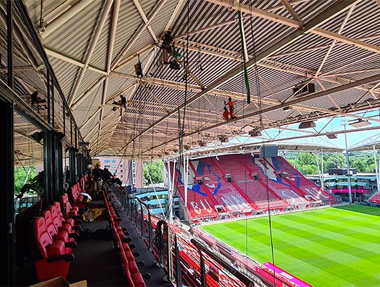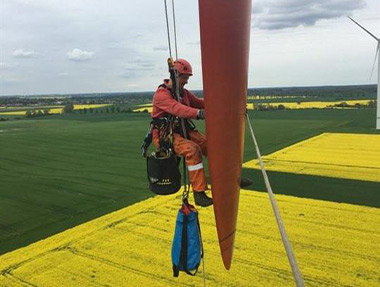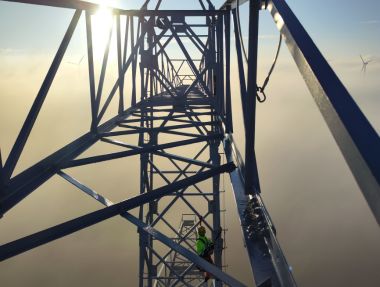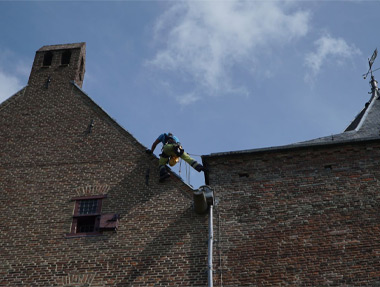What is rope access?
Rope access is an innovative technique that allows for safe and efficient access to hard-to-reach locations — both onshore and offshore. It is ideally suited for tasks on bridges, dams, oil platforms, tall buildings, and confined spaces.
By combining highly trained specialists with advanced equipment, we ensure safe and effective performance at height and in challenging environments.
A safer and more cost-effective alternative to scaffolding and aerial work platform
Rope access is a safe and cost-effective alternative to traditional methods like scaffolding and aerial work platforms. Thanks to strict safety protocols and certified techniques, our specialists can work efficiently in hard-to-reach areas such as tall buildings and confined spaces.
This method offers greater flexibility and requires minimal setup time, allowing projects to be completed faster. Our experienced team is ready to carry out inspections, maintenance and repairs — safely and without delay.
Curious to see what we can offer? The following topics will give you a clear picture.
Our approach
Contact us
Through our website, you can easily request a completely non-binding quote for your project. Of course, we are also available by phone or email!
Introductory call
Next, we would be happy to have a phone introduction to discuss your request and schedule an on-site visit.
On-site appointment
During the on-site appointment, we will conduct an inspection, assess the work, and of course, provide you with a price estimate.
Final quotation
Getting started
Our rope access specialists will carry out the work on the agreed dates.
More information?
Applicable across many industries
SkyPeople biedt de beste specialisten en technici voor vele branches. Denk hierbij aan:
• Maritime and offshore projects
• Process and petrochemical industries
• Civil engineering
• Wind energy
• Telecommunications
• Advertising and signage installation
These sectors all share one thing in common: the need for regular work in hard-to-reach areas. In every case, safety is our top priority.
With the right techniques, Sky People guarantees a safe working environment. In other words, we ensure both safety and quality to get the job done properly.
Explore some of the work we’ve delivered across industries
Rope access is the ideal solution for your project
In these industries, conventional methods are often unsafe — or simply not feasible. Traditional approaches like scaffolding or aerial work platforms may not provide the access or flexibility required. That’s where rope access offers the ideal solution: a safe and effective way to carry out the necessary work.
Rope access uses rope-based climbing techniques to reach areas that are otherwise difficult to access. This allows us to safely and efficiently navigate around obstacles to perform work at height — whether it’s inside confined spaces or just above the waterline.
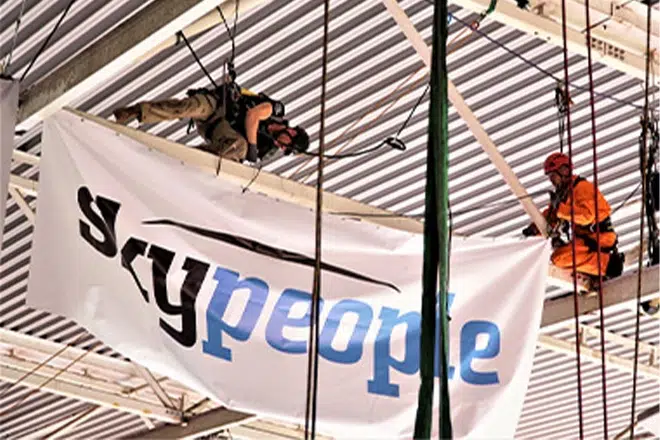
This method of working at height causes minimal disruption to surrounding operations. Project setup times are short, allowing for a quick and efficient start. Rope access offers numerous advantages — not only in terms of safety, but also in functionality and continuity of work in and around the site.
We've got your rope access covered
Are certain parts of your building or structure difficult to access using traditional methods like scaffolding or aerial work platforms? Do you want your project to be completed efficiently, effectively, and safely? Then Sky People is the right partner for you.
We take care of the entire process. At Sky People, we handle everything — matching your project, request, or vacancy with the right people and teams. That way, you can focus on what truly matters.
With Sky People, you’re guaranteed the capacity, safety, and professionalism needed for rope-based access and climbing techniques.
500+ projects completed annually across the Netherlands and EU
Frequently Asked Questions
Rope access is a proven method for working safely at height. Using ropes, climbing techniques, safety systems, positioning equipment, tools, and specialized gear, technicians can access locations that are otherwise difficult or dangerous to reach.
In many cases, conventional methods like scaffolding or aerial work platforms are not feasible — or even unsafe — especially when working at extreme height or depth.
This includes work environments above water, inside confined spaces, areas with fall hazards, or on tall structures where stability is a concern.
Rope access techniques are used across a wide range of disciplines, including cleaning, inspection, maintenance, and technical services.
What sets this method apart is the fast setup and dismantling time, its excellent safety record, and minimal impact on the surroundings and environment. These advantages are making rope access an increasingly common and popular solution in various industries.
Rope access is the perfect solution in situations where scaffolding, aerial work platforms, or other conventional methods are not possible, safe, or cost-effective.
Using specialized rope techniques, we provide access to hard-to-reach areas — such as surfaces above water or narrow, confined spaces.
We operate in a wide range of industries and carry out a broad variety of tasks. These include sectors such as Maritime & Offshore, Process & Petrochemical, Civil Engineering, Wind Energy, and Telecommunications. In addition, we also perform height-related work on churches, castles, and other unique or historic buildings.
It offers several key advantages, including:
-
Enhanced safety when working at height — all our specialists are IRATA-certified
-
Easier access and smoother execution of the work
-
Minimal to no disruption to the surrounding environment
IRATA stands for Industrial Rope Access Trade Association. It is a globally recognized quality label focused on safe working at height using industrial rope techniques. IRATA certification ensures the highest standards of safety and quality in rope access operations.
Within the IRATA framework, there are three certification levels:
Level 1 – A certified technician authorized to carry out specific tasks under the supervision of an IRATA Level 3.
Level 2 – An experienced technician with additional training, qualified to perform advanced tasks such as rigging and rescue operations.
Level 3 – A supervisor with full responsibility for the project and team, including safety, planning, and execution.
Our team consists of various specialists, each with their own skills and expertise. That’s why we’re happy to help you determine which professional best fits your project needs. Feel free to contact us — we’re here to help.
In making the right match, we don’t just look at IRATA certification or years of rope access experience. We also value the technical background and trade skills of our personnel. Many of our climbers are also welders, painters, mechanics, or other qualified professionals.
At first glance, rope access techniques may seem risky — but in reality, they have some of the best safety statistics of all methods used for working at height.
While setting up the scaffolding needed for a job can take several days, preparing for rope access usually takes just minutes to a few hours.
Sectors
- Oil and gas
- Wind
- Telecom
- Maritime
- Food
- Energy
- Waste processing
- Petrochemicals
- Construction, real estate and monuments
- Infrastructure
- Government
- On- and offshore
- Churches and castles
Services
- Tower and high-rise buildings
- Bridges
- Stadiums and theaters
- Advertising and promotion
- Silo and tank maintenance
- Painting
- Maintenance and repairs
- (Non-destructive) inspections
- Cabling and pipe installation
- Electrical installations
- Mount antenna systems
- Building insulation
Rope Access & IRATA
Although working at height involves certain risks, rope access is one of the safest methods for reaching difficult-to-access areas. All specialists at Sky People are IRATA (Industrial Rope Access Trade Association) certified.
This quality label is focused on ensuring safe execution of work at height using industrial rope techniques, guaranteeing both safety and work quality in every project.
IRATA has become the global standard for certified work at height. The certification consists of three levels:
- Level 1: Basic training
- Level 2: Advanced training
- Level 3: Specialist training
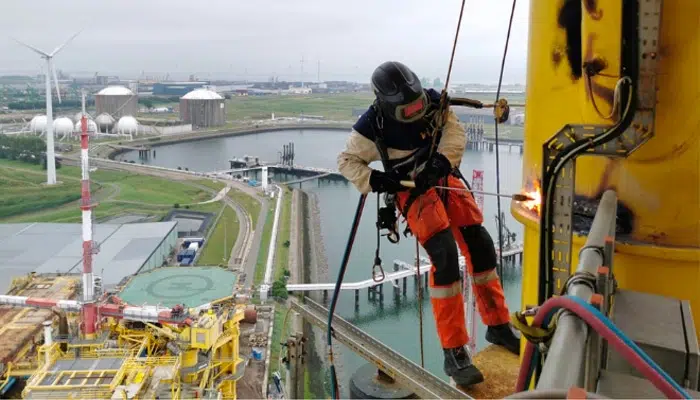
Certified specialists
When we carry out work for you, we do so with experienced specialists — all properly certified and holding at least IRATA Level 1 as a minimum requirement.
Level 1 specialists are always accompanied by colleagues certified at Level 2 or 3. This allows us to guarantee a safe working environment and ensures that our team has all the skills required to perform the job properly.
Each of our specialists has the necessary knowledge of general rigging principles. These include the following:
- Knot tying and proper rope handling
- Basic anchoring techniques
- Risks to ropes and how to protect against them
- Basic rope access maneuvers for ascending and descending
- Aid climbing, including knot-passing techniques
- Rescuing colleagues by descending techniques
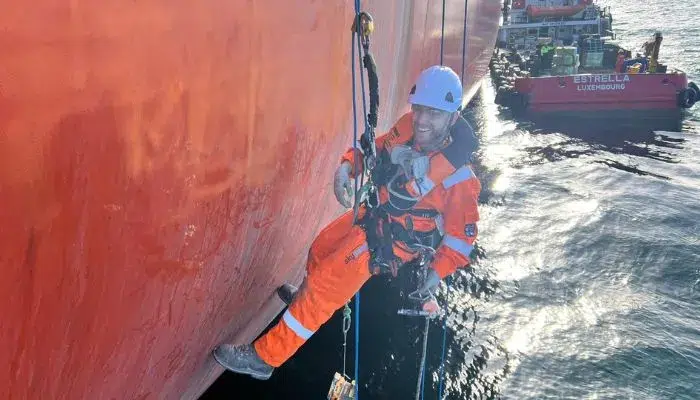
The ideal combination of safety and quality
In short, we use rope access to reach hard-to-access areas across various industries — from working above water to entering confined spaces.
Carrying out this work safely is, of course, essential. Traditional methods like scaffolding and aerial work platforms can’t always guarantee that level of safety — but our specialists can.
Need personnel for a short- or long-term project?
Need personnel for a short- or long-term project? Work efficiently, safely, and quickly with the rope access specialists from Sky People. We’ll match you with the professional best suited to your specific needs.
Feel free to contact us anytime — no strings attached.
Equipment rental for rope access work
At Sky People, it's possible to rent rope access equipment. Our rental offering consists of several essential components. Below is a list of the materials included:
- Ropes
- Harnesses
- Anchorage points
- Descenders
- Safety systems
The ropes form the foundation of the equipment. This includes various types such as dynamic, static, and semi-static ropes.
A harness is one of the most essential components of the safety system. Several options are available, including sit harnesses, chest harnesses, and full-body harnesses.
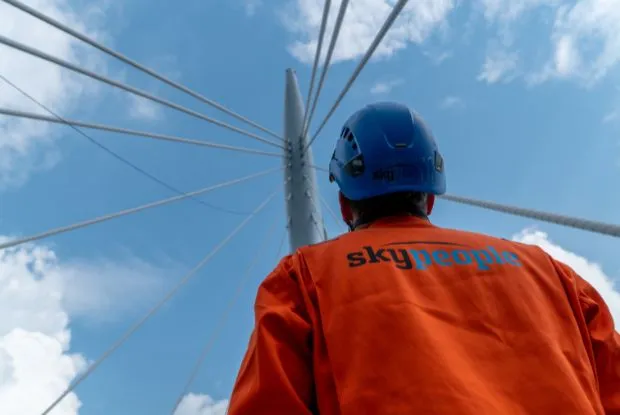
The anchorage points are the fixed positions where harnesses and ropes are secured. These points must be strong and reliable to ensure the safety of the technicians.
The descenders are used to control and stop the speed of descent.
The safety systems provide additional protection for technicians against fall hazards. These systems can be integrated with harnesses, ropes, and anchorage points.
Don’t see the exact equipment you’re looking for? No problem! Feel free to ask about the available options below — no obligation.
Your rope access company
Looking for a rope access company? Then Sky People is the right place for you. We’ll match you with the right specialist — often within 24 hours — for both short- and long-term projects.
We currently handle over 500 projects per year across the Netherlands and the EU. And we’re aiming to complete many more in the near future. Our specialists are ready to get to work for you.
Have questions? Feel free to contact us below — no strings attached.






